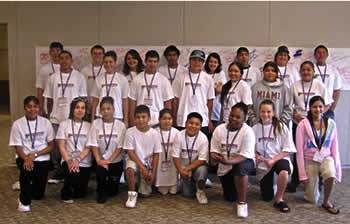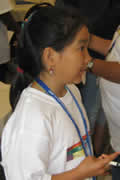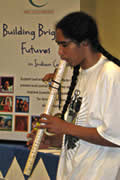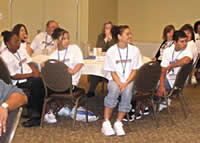in Indian Country

OJJDP recently conducted a tribal youth focus group, "Building Brighter Futures in Indian Country," to encourage an open dialog among tribal youth about their communities, families, and life experiences. Boys and girls ages 10 to 17 from 20 tribes across the United States participated in this effort, which will aid the Federal Government in creating programs responsive to tribal youth needs.
Two adult-facilitated focus groups were held, one with 12 youth ages 10 to 14 and one with 13 youth ages 15 to 17. A sampling of the questions asked youth, and the answers they gave, follow.

Focus group participants.
|
Youth Ages 10 to 14
- What are some positive things you could say about youth today?

Desiree Cleveland, Yupik Eskimo/Native Village of Kwinhagak.
|
- There are more programs for us to get to know each other on the reservation.
- Programs help the community and the kids to learn good choices. They include the Boys and Girls Clubs; a drum group, dancing, and powwows; and the Why Am I Tempted? (WAIT) program.
- There are more sports activities and a youth drop-in center with special activities.
- Are your peers using alcohol and drugs?
- Twelve out of twelve said yes.
- What are some of the problems facing youth today?
- Some parents drink and don't watch their kids and then the kids want to be like their parents.
- Gangs, drinking and smoking, and parents not watching their kids. Teen pregnancy.
- Kids not being involved in positive activities and feeling neglected, "like nobody wants them."
- What steps would you take to eliminate the problems youth face today?
- "Kids are going to drink no matter what because it is 'cool' and it solves their problems."
- "You can tell kids all you want and they will do what they want till something 'big' happens that will get them to change. The only way they will stop is if it is for themselves."
- "Community centers for teens to get together and talk about their problems might help."
- "Sports programs can be good. Many of them have a drug/alcohol policy: if you use them, you're kicked off the team."
- What is it like to be a Native youth in today's world?
- "It's cool to be me. But I'd really like to be like my grandma."
- "It's nice to be little still—when you get older, it isn't fun any more."
- "Good. The tribe is trying to make things better."
- "It's stressful having divorced parents and people judge me because of things other family members have done."
Youth Ages 15 to 17

Christian Hopkins, Naragansett Indian Tribe.
|
- Are your peers using alcohol and drugs?
- All 13 participants raised their hands. Drugs mentioned included marijuana, Ecstasy, ice, methamphetamines, snipes, bulbs, cocaine, alcohol, prescription drugs.
- What is causing so many youth to turn to alcohol and drugs?
Answers included:
- Peer pressure, acceptance, to be cool.
- They like the feeling; it's fun.
- New experience.
- Family issues.
- No attention at home.
- Get angry or depressed and use drugs/alcohol to make themselves feel better.
- School-related problem(s).
- "Nothing else to do but party."
- Is bullying a problem in your school?
- "Yes, but mostly between races."
- "There is bullying between gangs and in the gang initiation process."
- "There is a lot of 'drama' between girls."
- Do you feel safe in your community? (Answers ranged from "no" to sometimes "yes.") What can be done to help youth feel safe?
Answers included:
- Have youth work with adults in the police departments and courts.
- Clean up the community; eliminate graffiti.
- Form a youth council.
- Give youth jobs.
- When you think about the future, what do you see yourself doing?

Youth group table.
|
- "A business person."
- "I want to go to school and travel before I make any major decisions."
- "Finish high school and go to college and get a good job."
- "I don't think about the future."
- "I used to think about the future but I stopped because if it didn't work out, it would be a big disappointment. I used to want to be a news reporter or a teacher."
- Over half the group wanted to work for their tribe.
Chaperone Comments
A separate chaperone discussion group composed of parents and program managers also was held. Some of their comments follow.
- Youth are willing to get involved in their communities through volunteering, assisting elders, and participating in programs such as Head Start, Boys and Girls Clubs, and health and awareness programs.
- Lack of parenting skills and guidance from their parents are a serious problem facing youth.
- Adults who work with children in school notice their lack of concentration and focus. Children have a hard time sitting still and listening to adults.
- There is a "fluency gap" with the youth's parents. There was a generation lost when there were no language or cultural activities including dancing, singing, or drumming. Most of the people who can speak the native language are over 50.
- Nevertheless, youth are involved in language programs and cultural programs including drumming, singing, dancing, and powwows. Youth are interested in learning the culture, arts, and native crafts. Comments included: "If it's offered, they'll get involved," and "When the adults start to talk about the culture or tribal history or language, you can hear a pin drop. The kids are thirsty for this kind of information."
Based on the focus group's findings, a final report with future recommendations for Federal efforts to assist tribal youth will be developed in autumn.
For more information on the tribal youth program, visit www.ojjdp.ncjrs.gov/typ.
|

